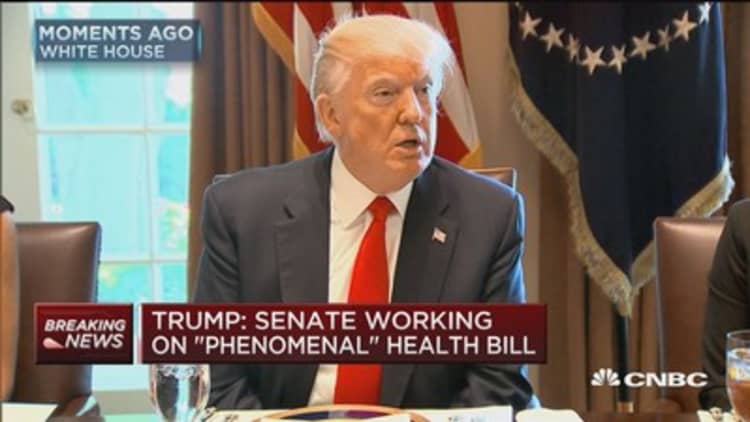All of those yellow and red spots? They aren't good news for Obamacare.
Federal health officials on Tuesday released a new map showing in full color how many counties in the United States could have zero or just one insurer selling Obamacare health plans in 2018.
Large of swaths of yellow cover a number of Southern and Midwestern states, all of Alaska, and elsewhere indicating counties that are projected as of now to have just one insurer selling individual plans next year.
As many as 1,200 counties, almost 40 percent of all counties nationwide, containing 2.4 million customers of Obamacare exchanges, are colored yellow.
Another 47 counties strewn across Ohio, western Missouri and Washington are colored red. The red indicates that no insurer is expected to sell plans there in 2018.
At least 35,000 current customers of the government-run insurance exchanges live in "red" counties.

The map was released by the Centers for Medicare and Medicaid Services, the federal agency responsible for overseeing Obamacare. The map is based on intentions for next year revealed by insurers as of late last week.
President Donald Trump, after a lunch with a group of Republican senators who soon hope to introduce a health-care reform bill, said, "One in 3 counties will have only a single insurer."
"Obamacare has been broken, it's been a broken promise," Trump said.
Since Trump's inauguration, CMS' leaders, and that of its parent, the Health and Human Services Department, have gone from being the main cheerleaders for Obamacare to being among its harshest critics.
"This is yet another failing report card for the [Obamacare] exchanges," said CMS Administrator Seema Verma.
"The American people have fewer insurance choices and in some counties no choice at all."
"CMS is working with state departments of insurance and issuers to find ways to provide relief and help restore access to health-care plans, but our actions are by no means a long-term solution to the problems we're seeing with the insurance exchanges," Verma said.
CMS said it expects the number of customers with no coverage options next year to rise.
But the agency also noted that the map's picture of exchange participation "is expected to fluctuate" as insurers disclose their intentions in coming weeks.
Obamacare defenders have accused the Trump administration of sabotaging the individual insurance markets by pushing for a bill that would repeal and replace key parts of Obamacare. They also criticize the administration and congressional Republicans for refusing to guarantee that insurers will continue being reimbursed for billions of dollars in subsidies offered to low-income customers to limit their out-of-pocket health costs.
The map's release comes a week after big insurer Anthem said it was effectively abandoning Ohio's Obamacare market in 2018, leaving 18 counties there with potentially no insurer, and after Washington's insurance commissioner revealed that two counties could be "bare" of Obamacare insurers next year in that state.
Anthem had cited the uncertainty about the Trump administration's funding of so-called cost-sharing reduction subsidies in its decision.
In Iowa on Monday, state officials asked the federal government to allow the state to use $352 million in funding as a stop-gap measure to ensure that all 99 counties Iowa have an insurance plan available to residents. Iowa as of now has just one insurer, Medica, that as of yet has not indicated it will exit the state next year.
Last week, Vice President Mike Pence visited the state, and gave a speech that highlighted the problems one couple, Craig and Cindy Williams of Manning, Iowa, have had with their Obamacare coverage, both in terms of rising costs, and now in terms of availability.
Craig Williams, an agriculture consultant who is chairman of county's Republican Party committee and member of the party's state committee, told CNBC that he and his wife were originally paying $1,100 per month for their Wellmark plan in late 2015.
"Now it's $1,700 per month," the 53-year-old Williams said. That's a 55 percent increase in premiums alone.
"We're talking up to $20,000 in premiums" for a year, which is not an insignificant amount for the couple's household budget, he said.
And "then our deductible went from $1,000 per person to ... $3,600 per person," Williams said, referring to the payments that he and his wife must make before their insurance covers the cost of a variety of health services.
Williams said the rising cost of the couple's insurance was bad enough, then they learned in April that Wellmark wouldn't sell plans in the state next year.
Now Williams is worried that Medica will leave the state, leaving the couple with no option for health insurance next year.
"We've always had health-care coverage, and it's just been part of our life forever," Williams said. "The thought of not having it anymore is scary."
He noted that he and his wife are both in good health, at the moment, and don't use their insurance coverage heavily.
"I don't really need the insurance now," Williams said. "But if something catastrophic happens then everything we've worked for my entire life is at risk."
Having an Obamacare plan is "expensive," Williams said. "But not having insurance is probably more expensive."
Williams said he has not paid close attention to the Republican-backed bill that passed the House of Representatives last month that would significantly reform Obamacare.
Nor has he, or anyone else in the public, seen the draft of a similar bill GOP members of the Senate are working on, because that drafting has been done in secret.
But Williams is worried that officials are running out of time in coming up with something that could address the risk to him and many other people who could have no options for insurance next year, or only an expensive option.
"I asked that question to the vice president," William said. "'Are we too late?'"
"He said, 'I don't think so.'" Williams said. But Pence added, according to Williams, "'We've got a lot of work to do.'"
Watch: Prescription for healthcare uncertainty



